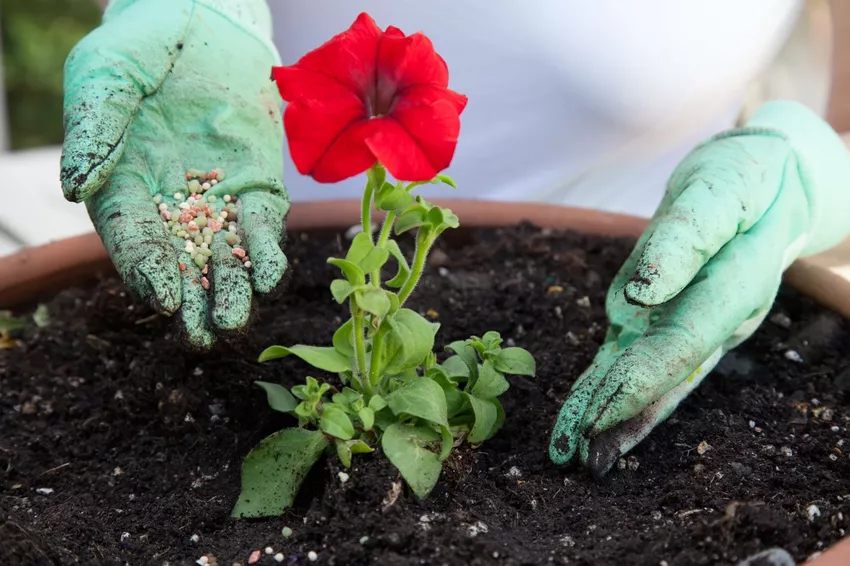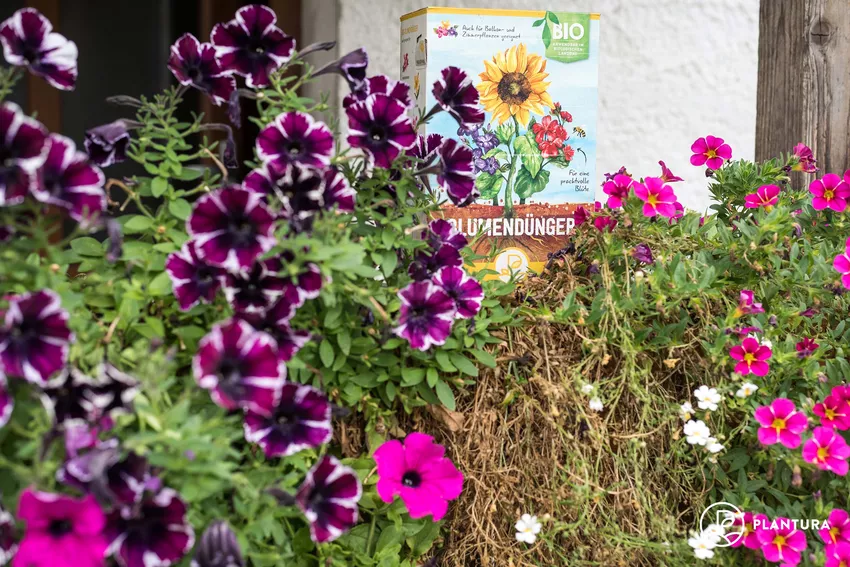As a heavy feeder, the petunia needs a lot of nutrients. We show when and how to properly fertilize petunias with home remedies and co.

Bright petunias (Petunia) with their numerous, funnel-shaped flowers are often found in home gardens and on balconies. The nightshade plants (Solanaceae) originally come from South America, where they like to colonize rocky slopes. There are different standing and hanging petunia varieties that are suitable for both bedding and pot planting. What they all have in common is that they are relatively undemanding and robust when it comes to care. However, if you want to enjoy lots of colorful flowers, you should feed your petunias regularly. In this article we will show you how you can optimally support your petunias in their development with the right fertilization and thus get them to perform at their best.
Petunias are characterized by their strong growth and have to absorb a lot of nutrients from the soil. Needs-based fertilization is therefore very important. With favorable weather conditions and the right care, your petunias will delight you with their blooms well into autumn. We will explain below when and with what to best fertilize your petunias in beds and pots.
When do you fertilize petunias?
A need-based fertilization of petunias begins with planting. Basically, the small summer bloomers prefer sunny locations with slightly acidic soil (pH value of 5.5 to 6). In order to give the plant good starting conditions, it is best to put some rich compost or potting soil in the planting hole when planting (mid-May). You should also ensure sufficient planting distance (at least 15 centimetres) so that there is no competition for space or nutrients. You can also work a long-term fertilizer into the soil when planting petunias. It is best to use fertilizers with an organic long-term effect, such as our Plantura organic flower fertilizer. This is particularly environmentally friendly for people, plants and animals in the garden.

In general, petunias are happy to be fertilized regularly from May to October. As an alternative to long-term fertilizers, you can add a phosphorus-rich liquid fertilizer monthly to the irrigation water at the beginning of the growing season, which will provide your petunias with sufficient nutrients. During flowering you can then fertilize every two weeks or even weekly to help the plant flower profusely and for a long time. Petunias are usually only cultivated once a year and then migrate to the compost in autumn. With a little effort, however, you can easily get your petunias through the winter. You can find more information about overwintering petunias here. In terms of nutrient supply, you should note that no fertilizer is used during the hibernation period (September to February). The old substrate is not replaced with a new one until spring (March) and when the petunias move back into the bed in mid-May, fertilizer can be applied again.
An aspect that should also be considered right from the start is that the vigorous petunias often suffer from an iron deficiency, for example if they are regularly watered with lime-rich water and the pH value in the soil increases as a result. In the worst case, the leaves turn yellow and only show green leaf veins. You can already counteract such an iron deficiency when planting by using a special petunia soil. If necessary, you can also give iron fertilizer or a fertilizer containing iron for petunias.
When do you fertilize petunias?
- Add compost or potting soil to the planting hole
- Incorporate fertilizer with organic long-term effect
- Alternatively administer liquid fertilizer first monthly, then weekly
- Do not fertilize during hibernation
- Exchange old substrate for fresh one in spring
- Counteract iron deficiency with special petunia soil
- Administer iron fertilizer if necessary

What is the best way to fertilize petunias?
There are several ways you can provide your petunias with adequate nutrients. In the following, we explain the advantages and disadvantages of the individual fertilizing methods and what you need to consider when fertilizing petunias in pots.
Fertilize petunias primarily organically: The right approach
Your garden may already contain valuable natural fertilizers that are ideal for theNutrient supply of petunias are suitable. A good example of this is mature compost, which can be incorporated into the soil prior to planting. Rotted stable manure (e.g. horse manure) can also be put to good use in the garden. If natural fertilizers are not available to you, you will make the right choice with an organic fertilizer with an organic long-term effect, such as our Plantura organic flower fertilizer. This has some advantages.
What are the advantages of an organic long-term fertilizer?
- Long-term nutrient supply through ongoing decomposition via microorganisms in the soil
- Promotion of active soil life (good for earthworms, microorganisms etc.) and sustainable improvement of the soil structure
- Protection of the environment by not using chemicals
Our Plantura organic flower fertilizer is mainly made from organic plant residues from the food, feed and semi-luxury food industry. The composition of the fertilizer is ideal for the nutrient supply of your petunias. A high nitrogen content promotes plant growth and leaf formation, especially in spring. Sufficient phosphorus and potassium also ensure rich flowering later in the year. Of course, when it comes to fertilization, it is not just about the optimal composition, but also about the right amount of nutrients. To ensure that you provide your petunias with the right amount of fertilizer, we have prepared detailed instructions for you below.

Organic Long-Term Fertilization: Instructions & Dosage Amounts For Petunias
- When planting in the bed, lightly work about 100 - 150 g/m² (8 to 12 heaped tablespoons) of our Plantura organic flower fertilizer into the top layers of soil
- Water freshly planted petunias well so that the granules can loosen
- After 2 months, fertilize again with 80 - 120 g/m² (6 to 10 heaped tablespoons)
- Fertilize about 4 to 6 g per liter (1 to 2 teaspoons) when planting when cultivating in pots, add about 4 g per liter again after 2 months
Fertilize petunias with minerals
Blue grain, liquid fertilizers & Co. are still used by hobby gardeners as a universal product in the garden. The nutrients are in pure form in mineral fertilizers and are therefore directly available for the plant. However, the fertilizing effect is usually only of short duration. In additiondue to the easy solubility of the nutrient s alts, there is an increased risk of over-fertilization. If used improperly, these can even be washed out into deeper soil layers, where they lead to contamination in the groundwater. Primarily organic fertilizers work much more slowly because they first have to be broken down by the microorganisms in the soil, but they are much gentler on the environment and promote the development of your petunias more sustainably.
Fertilize petunias with home remedies
An ideal care addition for petunias, which can be found in almost every household, is a fertilizer made from coffee grounds. Because the actual waste product contains vital plant nutrients such as nitrogen, phosphorus and potassium. Introducing organic matter also improves soil structure and attracts beneficial soil organisms, which loosen the soil and make it permeable.

The sour coffee grounds are also ideal for petunias because they lower the pH value in the soil or substrate. Whether for bedding or pot plants, using coffee grounds as a fertilizer is very easy to use. It is best to dry the brew first to prevent mold from forming. Then occasionally (every few months) sprinkle some of the powder around the plant and work it lightly into the soil. You can also dilute smaller amounts with plenty of water and administer over the irrigation water. Exclusive fertilization with coffee grounds is not recommended. It is best to also fertilize with a primarily organic fertilizer in order to meet the high nutrient requirements of the petunias.
If you fall more into the tea drinker category, you can also use green tea to fertilize your petunias. Unlike coffee grounds, tea is high in iron, making it ideal for feeding petunias regularly. Simply prepare a strong green tea and let it cool down. Then dilute it with water and water the plant with it. You can also use the tea grounds. It is best to dry this and occasionally mix it into the ground. It is then gradually decomposed by the soil organisms and releases the nutrients it contains for the petunia.
Fertilize petunias in pots: you should pay attention to this
Petunias are not only beautiful to look at in the garden bed, they are also ideal for planting in a pot. Hanging varieties decorate balcony boxes or hanging baskets, for example. But also inPetunias look great in boxes, barrels or troughs. Simply fill the selected planter with nutrient-rich bed or balcony plant soil. If necessary, you can also mix in some moorbed soil to ensure a lower pH value. If you are willing to spend a little more money, you can also use special iron-containing petunia soil from specialist shops. In order to avoid nutrient competition, you should always make sure that you choose a sufficiently large planter and not plant too many plants in one pot. A maximum of five petunias should be planted in a large window box and a maximum of two to three petunias in hanging baskets.

So that the newly planted petunias can grow well, it is advisable to incorporate a fertilizer with an organic long-term effect - such as our Plantura organic flower fertilizer - into the substrate when planting. Since the nutrient uptake is limited by the pot volume, it should also be fertilized regularly. If you water with hard, lime-rich tap water, it is particularly important to ensure that the petunia always has sufficient iron available. For example, special iron and petunia fertilizers are commercially available, which can be administered via the irrigation water or as foliar fertilizer. To counteract a deficiency, you should also repot your petunias annually and change the substrate.
In this special article we have summarized what else you need to consider when caring for petunias.